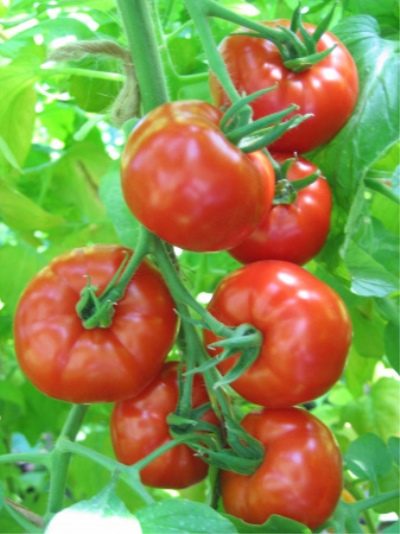
- Year of approval: 1996
- Category: hybrid
- Growth type: determinant
- Appointment: fresh consumption, for pickling and preserving
- Ripening period: mid-early
- Ripening time, days: 110
- Growing conditions: for closed ground
- Bush size: medium-sized
- Bush height, cm: 120
- Bush characteristic: powerful
Tomato Energo was specially bred by breeders for growing it in greenhouses, as well as in the open field. The hybrid of the first generation is easy to care for and has a good yield. The tomato is highly resistant to most diseases and tolerates unfavorable weather conditions.
Breeding history
The variety was created in 1996 by domestic breeders on the basis of the Kirov research and production company "Agrosemtoms". The culture is especially in demand among vegetable growers because of the ability to get an early harvest in any conditions.
Description of the variety
Plant of determinant type. In a greenhouse, the bush reaches a height of 1.5 meters, in open ground no more than 1 m. The hybrid got its name due to the intensive growth of the stem and ripening of the fruits. Bushes are rather compact, semi-spreading, with few shoots and leaves. The foliage is a rich dark green color, slightly corrugated. The first fruit cluster is laid above 8-9 leaves, on the second shoot above 3-5. Subsequent ones are formed every 2 sheets.
The main qualities of the fruit
Tomatoes have a regular, rounded shape. On average, the weight of one fruit is 140 grams. The tomato color at the beginning of ripening is green with a dark spot at the stalk. When fully ripe, the color becomes a uniform red. The rind is dense, glossy. Transportability and keeping quality are excellent. The harvested crop retains its presentation and taste for a long time.
Taste characteristics
Energo has a classic tomato flavor. The taste is sweet and sour, harmonious due to the balanced combination of sugars and acids. The hybrid is characterized by a universal purpose. They are used not only fresh in salads. Small tomatoes are convenient for canning.
Ripening and fruiting
Refers to medium early varieties. The first tomatoes are obtained 105-110 days after the appearance of the first shoots. Harvesting is carried out from July to August. Maturation is amicable.
Yield
Tomato Energo is high-yielding. Under the film, 12-22 kg are collected from 1 sq. m. Outdoors 7-10 kg. With proper agricultural technology, the yield can be increased to 32 kg. Ripe tomatoes are harvested as they ripen. There is no need to delay the collection - this negatively affects growth.
The timing of planting seedlings and planting in the ground
They start sowing seeds in such a way that until the time of transplanting the seedlings to a permanent place, the seedlings will be at least 50-55 days. As a rule, the event is held at the end of March. Overgrown bushes take root less well and grow slowly, which leads to a decrease in yield.
Despite the fact that the culture is not too demanding on the composition of the soil, it is better to give preference to ready-made soil for growing seedlings. Such soil mixtures contain the necessary composition and neutral acidity for full development.
After the seeds have been planted, they need to create favorable conditions. Until the emergence of shoots, the temperature should be 23-25 degrees. After that, the temperature is reduced by 5-7 degrees. Watering is moderate. The soil should not dry out or be waterlogged. Lighting is of particular importance in the development of seedlings, which should be at least 12-13 hours a day. At the stage of development of 2-3 leaves, a pick is carried out.

Growing tomato seedlings is an extremely important process, because it largely depends on whether the gardener will be able to harvest at all. All aspects must be taken into account, from seedbed preparation to planting in the ground.
Landing scheme
Saplings should be planted according to the scheme 70x40 cm from each other. For 1 sq. m you can plant no more than 3 bushes.

Growing and care
Since the hybrid quickly gains vegetative mass, the root system may suffer from this. It forms weak and superficial. An earthen coma may not have enough nutrients and moisture to grow well. In addition, Energo tends to produce a large number of fruits to the detriment of the development of stems and roots. Therefore, in order to get a good harvest, the plant needs constant watering and feeding.
Abundant irrigation is carried out every 2-3 days. If the weather is hot and dry, increase watering. Complex fertilizers are applied at the root once a week. The bush is formed into 2-3 stems. When growing tomatoes in a greenhouse, experienced gardeners are advised to normalize fruit ovaries. For this, no more than 4 brushes are left on the bush. Cultivation conditions depend on regional climatic characteristics.
There is also an easier way of leaving. Plant the plant in open ground, do not fertilize or water, but on condition that it rains weekly. Under such circumstances, the tomato grows short. The stepchildren are removed before the first flower ovary, leaving as many brushes as they have time to ripen during the vegetative period.
Energy requires a binding garter to the support, even when it grows short. Do not forget about regular weeding of beds from weeds and loosening of the soil.




A plant needs different micronutrients at each stage of growth. All fertilizers can be divided into two groups: mineral and organic. Folk remedies are often used: iodine, yeast, bird droppings, eggshells.
It is important to observe the rate and period of feeding. This also applies to folk remedies and organic fertilizers.
Disease and pest resistance
The variety is highly resistant to infections.He is not afraid of late blight, he is not sick with the tobacco mosaic virus, cladosporiosis and any types of rot.



























































































